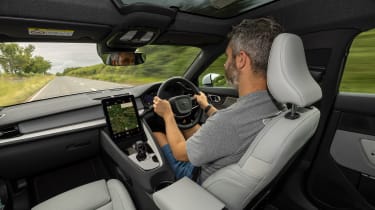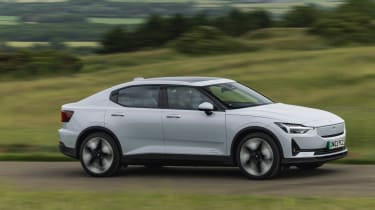New Polestar 2 Long Range 2023 review
Big range and efficiency improvements are offset by the same choppy ride in the latest revised Polestar 2

Verdict
While writing this review, our verdict swung wildly from three stars to five, before eventually settling somewhere in the middle. The revised Polestar 2 is a good set of dampers and a slightly softer chassis setup away from being a truly fabulous electric car. It’s great to drive, filled with tech, and the cabin feels plush for the price, yet most buyers will find a BMW i4 or Tesla Model 3 more comfortable. In this space, that matters.
At a time when companies and consumers are looking long and hard at their environmental impact, it may not be coincidence that Polestar – which has reduced the 2’s cradle-to-gate CO2 impact (the CO2 emissions during the car’s production phase) by three tonnes since the model launched in 2020 – is seeing sales really surge year-on-year.
The maker has now sold over 100,000 Polestar 2s globally – 17,000 of which have found homes in the UK. And while bosses will tell you Polestar “doesn’t do facelifts per se”, the most recent round of ‘model year 2024 changes’ are said to be “really important for the customer”.
In spite of those comments, there are some changes to the styling. Instead of the patterned grille found on the outgoing cars, new models feature the brand’s body-coloured SmartZone. It hides the various radars and cameras and brings the 2’s look in line with the upcoming Polestar 3 SUV. Optional forged aluminium wheels also feature.
Used - available now
Inside, the 2’s cabin will feel familiar to anyone who’s sat in or driven the car before. There are no specific changes, though Polestar is keen to point out that its cars are continually improving – with 15 over-the-air (OTA) updates since launch, “even the oldest cars feel new”, apparently.
Subjectivity aside, it’s hard to argue with the numbers. The Polestar 2 allegedly consumes up to nine per cent less energy, can travel up to 22 per cent further, and charge up to 34 per cent faster than before. In fact, with a WLTP range of 406 miles, only a Mercedes EQS can officially manage more miles than the Long Range Single Motor model driven here.
These upgrades come courtesy of a new 82kWh battery and an electric motor which, like in the Volvo XC40 on which the Polestar 2 is based, has moved from the front axle to the rear. Dual Motor models with a rear power bias are also available.
Alongside those tangible efficiency improvements, Polestar puts strong emphasis on how that shift makes the 2 “even more fun to drive”. Again, not something we wish to dispute – this is a car that quite convincingly gives the BMW i4 a run for its money when it comes to pinpoint precision.
Yet there’s one thing about the Polestar 2 that we’ve always taken issue with, and something we’d hoped might have been rectified with these extensive model year updates. Alas, no – the Tesla Model 3-rivalling hatchback is still too firm for UK roads.
On smooth tarmac the Polestar is just fine. But any kind of camber, lump, or broken surface causes the car to bounce about – resulting in a constant (and occasionally quite unbearable) fidget over a typical British B-road. If your commute encounters this kind of rural road on a regular basis, an i4 will be the more pleasant car to live with. It’s even worse in the back; those with children prone to motion sickness – you have been warned.
It’s a shame, because even in Single Motor guise, the Polestar 2 is quick. Throttle response is instantaneous and while the regenerative brakes aren’t as binary as those you’ll find in the closely-related XC40, they’re progressive and feel conducive to a faster driving style. The steering is well weighted, too.
Ride comfort is little better around town, either. The Polestar’s platform is inherently quite stiff, but match this to the unforgiving damping and you’ve got a car that jumps about quite a bit at low speeds. Drive over a hump or hit a pothole, and instead of the shock being absorbed through the damping at the wheels, the whole car moves with it. Our test model was fitted with the optional 20-inch alloys; we’d be intrigued to try a car on the standard 19s to see if the situation improves.
The Polestar is actually at its best on the motorway, where everything seems to flow more smoothly. It’s relatively quiet and all of the above means it feels nicely tied down at 70mph. All that’s great, too, because with such a long range – we were seeing around 330 miles in mixed driving – you’ll not need to stop very often.
If you do, you’ll be back on the road in no time thanks to super-quick top-up times. The Long Range cars now max out at 205kW – the same as a BMW i4 eDrive40 – meaning a 10 to 80 per cent charge is possible in just 28 minutes.
The Polestar’s cabin remains a high point. You feel cocooned in the driver’s seat, and both the central screen and digital driver’s display offer crystal-clear graphics and plenty of functionality. The main screen continues to run an Android-based software system, but the integration of Google Maps and other apps is among the best we’ve experienced. Of course, wireless phone charging is standard fit, as is Apple CarPlay if you prefer to use that.
Otherwise, there’s no complicated specs to choose from. You pick your battery and motor configuration – a Standard Range Single Motor (£44,950) capable of 330 miles is also offered, alongside a Long Range Dual Motor (£52,950) – with every car getting the same basic kit list. That means each model gets LED lights, part-electric heated front seats, dual digital displays and a plethora of safety features.
On top of this, buyers can add the Pilot Pack (£2k) with pixel LED lights and adaptive high beam, plus adaptive cruise control and Pilot Assist. There’s also a Plus Pack (£4k), which brings a Harman Kardon stereo, panoramic roof and vegan seats.
| Model: | Polestar 2 Long Range Single Motor |
| Price: | £48,950 |
| Powertrain: | 82kWh battery, 1x e-motor |
| Power/torque: | 295bhp/490Nm |
| Transmission: | Single-speed auto, rear-wheel drive |
| 0-62mph: | 6.2 seconds |
| Top speed: | 127mph |
| Range/charging: | 406 miles/205kW, 10-80% in 28 mins |
| On sale: | Now |














